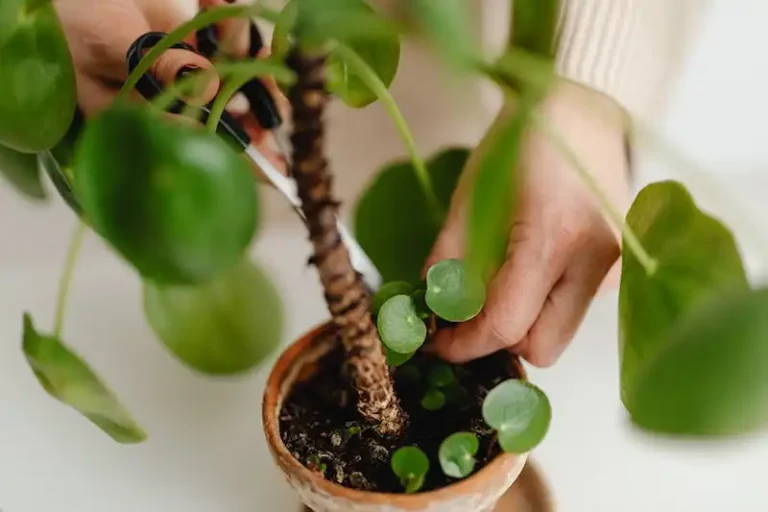When it comes to growing cauliflower, there are several common problems that can occur. One issue that many gardeners face is the presence of brownish-black spots on the leaves. These spots can be caused by a variety of factors, including fungal infections, such as mildew, or pests, like aphids. If left unchecked, these infections can spread to the whole plant and cause further damage.
Another problem that cauliflower plants can encounter is blackleg, which is a bacterial disease that affects the stems and roots. Blackleg can cause the stems to become discolored and mushy, and the roots may appear bluish-black. If your cauliflower plants suffer from blackleg, they may become defoliated and eventually die.
One common problem that can occur when growing cauliflower seedlings is bolting. Bolting is the premature flowering and seeding of a plant, and it can be caused by a number of factors, including stress from heat or cold weather. To prevent bolting, it’s important to provide your cauliflower plants with cool-weather conditions and ensure proper spacing between plants.
Additionally, cauliflower plants can be susceptible to a variety of pests, including aphids, caterpillars, and slugs. These pests can feed on the leaves and tender curds of the cauliflower, causing damage and reducing the quality of the harvest. To control these pests, you can use organic or chemical insecticides, such as Sevin, or implement preventative measures, like companion planting or using row covers.
In conclusion, growing cauliflower can come with its fair share of challenges. From fungal infections to pests and weather-related issues, there are many factors that can affect the health and productivity of your plants. However, with the right troubleshooting techniques and preventative measures, you can overcome these problems and enjoy a successful harvest.
Cauliflower Growing Problems Troubleshooting
When growing cauliflower, you may encounter various problems that can affect your harvest and the health of your plants. Here are some common issues and how to troubleshoot them:
- Yellowing or wilting plants: If your cauliflower plants start to die off, it could be due to a fungal disease called mosaic. This disease affects the inside of the plant, causing it to become weak and eventually die. To prevent this, ensure your soil has good drainage and avoid planting cauliflower in the same spot for several years.
- Irregular or whitish curds: If your cauliflower heads have irregular or whitish curds, it may be due to a condition called “buttoning.” Buttoning occurs when the cauliflower plants don’t have enough nutrients or are exposed to fluctuating temperatures. To prevent this, provide a consistent level of nutrients and avoid extreme temperature changes.
- Mold or mildew on leaves: Cauliflower plants can frequently develop mold or mildew on their leaves, especially when the weather conditions are moist. This can be prevented by providing good airflow around the plants and avoiding excessive moisture on the leaves. You can also use fungicidal sprays to control the mold or mildew.
- Purple discoloration on leaves: If you notice purple discoloration on the leaves, it may be a symptom of a nutrient deficiency, particularly phosphorus. Ensure your plants are adequately fed with a balanced fertilizer to prevent this issue.
- Small or misshapen heads: If your cauliflower heads are small or misshapen, it may be due to improper timing of planting or inadequate care. Cauliflower needs cool temperatures and consistent moisture to develop healthy heads. Make sure to plant at the right time and provide proper care throughout the growing season.
- Pest infestation: Cauliflower plants can be susceptible to various pests, such as cabbage worms and larvae. These pests can feed on the leaves and cause damage to the plants. To control them, you can handpick the pests or use organic insecticides.
- Storage problems: After harvesting, cauliflower should be stored properly to prevent spoilage. Make sure to remove any leaves and store the heads in a cool and dry place. Avoid storing cauliflower together with fruits or vegetables that produce ethylene, as it can cause the cauliflower to spoil more quickly.
By learning about these common cauliflower growing problems and how to troubleshoot them, you can increase your chances of success and have healthy, flavorful cauliflower heads to enjoy.
Seeds and seedling problems
One of the common problems that gardeners face when growing cauliflower is related to seeds and seedlings. Here are some issues that you might encounter:
1. Webbed Seedlings: Sometimes, your cauliflower seedlings might have webbed leaves. This can be caused by overwatering or insufficient sunlight. To troubleshoot this issue, make sure you provide adequate water and place your seedlings in a sunny spot.
2. Small Head Size: If your cauliflower heads are turning out smaller than expected, it could be due to improper growing conditions or nutrient deficiencies. Rotate the location of your cauliflower crops and ensure they get enough sunlight and nutrients.
3. Wilting Seedlings: Wilting seedlings can be caused by various factors, including root rot or bacterial infections. To prevent this, make sure you have well-draining soil and avoid overwatering. Also, be cautious of using infected plant debris as mulch.
4. Holes and Yellow Spots on Leaves: If you notice holes or yellow spots on cauliflower leaves, it could be a sign of pests. Frequently check for pests like cabbage worms or aphids, and take appropriate measures to control them.
5. Curled or Blighted Curds: Curled or blighted curds can be caused by certain fungi or viruses. To prevent this, ensure good air circulation around the plants and remove any infected plants. Additionally, avoid planting cauliflower near members of the Brassicae family to prevent the spread of diseases.
6. Bolting of Cauliflower: Bolting is when the cauliflower plant starts to send up a flower stalk prematurely. This can happen due to factors like temperature fluctuations or stress. To prevent bolting, plant cauliflower during cool-weather months and provide consistent care.
7. Late-Developing Heads: If your cauliflower plants are not producing heads within the expected time frame, it could be due to insufficient nutrients or poor soil conditions. Amend the soil with organic matter and provide necessary nutrients to ensure proper head development.
8. Pest Infestations: Cauliflower can be susceptible to various pests like aphids, cabbage worms, and flea beetles. Use organic pest control methods or install physical barriers like row covers to protect your plants.
Remember to frequently check your cauliflower plants for any signs of trouble. Early detection and prompt action can help prevent further damage and ensure a healthy harvest.
Seedlings fail to emerge from the soil, seedlings are eaten, roots are tunneled
One common problem with growing cauliflower is when the seedlings fail to emerge from the soil. There can be several reasons for this, such as improper planting depth, poor soil conditions, or inadequate moisture. To ensure successful emergence, it is recommended to plant cauliflower seeds at the correct depth according to the seed packet instructions, prepare well-drained soil with sufficient organic matter, and maintain adequate moisture levels.
If your seedlings are being eaten, it is likely that pests are the culprit. Common pests that feed on cauliflower seedlings include cutworms, flea beetles, and slugs. To protect your plants, you can use physical barriers like cardboard collars around the seedlings or apply organic pest control methods, such as neem oil spray or Bacillus thuringiensis (Bt) spray. Regularly inspect your plants and take appropriate measures to control pests.
Another problem is when roots are tunneled. This can be caused by root maggot larvae, which tunnel into the roots and cause damage. To prevent root maggot infestation, crop rotation is essential, as well as using row covers to protect young plants. If you notice signs of infestation, remove and destroy infected plants to prevent further spread.
Remember to keep an eye on your plants and regularly check for any signs of problems or pests. By taking preventive measures and following the tips mentioned in this article, you can ensure the healthy growth of your cauliflower and enjoy a bountiful harvest of this nutritious vegetable.
Seeds rot or seedlings collapse with dark water-soaked stems as soon as they appear
Growing cauliflower can sometimes present challenges, and one problem that growers may encounter is seeds rotting or seedlings collapsing with dark water-soaked stems as soon as they appear. This issue typically arises in late fall or early winter when the weather starts to become cooler.
When seeds are planted in soil that is too wet or the weather conditions are too damp, the seeds can easily rot. As they germinate and the seedlings start to grow, the stems may become dark and water-soaked, which is a sign of infection. This can be caused by a variety of factors, including fungal or bacterial pathogens in the soil.
Choosing the correct variety of cauliflower and properly preparing the soil can help prevent this problem. Ensuring that the soil has proper drainage and is not overly saturated with water is essential. Additionally, using a preventative measure, such as applying a fungicide like Sevin, can help protect the young seedlings from infection.
If your cauliflower plants have already been affected by this issue, there are a few steps you can take. First, remove any debris from the plant’s surroundings, as this can harbor pathogens. Then, gently remove the collapsed seedlings and dispose of them properly. Avoid planting cauliflower in the same area for at least a few years to prevent further infection.
It’s also important to note that temperature plays a role in the development of cauliflower curds. Cool-weather conditions are ideal for curd formation, and if the temperature becomes too warm, the curds may not develop properly. Additionally, nutrient deficiencies can cause the curds to turn yellow or grey. Regularly inspecting your plants for any signs of nutrient deficiencies is essential for healthy cauliflower growth.
If you notice any abnormalities in your cauliflower, such as dark brownish spots, curled leaves, or the presence of worms or other pests, it’s important to address these issues promptly. Brown or curled leaves may indicate a lack of water or nutrient deficiency, while worms can cause damage to the plants. Applying a suitable pesticide and addressing any nutrient deficiencies can help manage these problems.
In conclusion, if you are experiencing issues with seeds rotting or seedlings collapsing with dark water-soaked stems, taking preventative measures such as choosing the right variety of cauliflower, preparing the soil correctly, and protecting against pathogens can save you from potential crop loss. Regular inspection and timely action to address any issues can help ensure healthier cauliflower plants and better yields.

